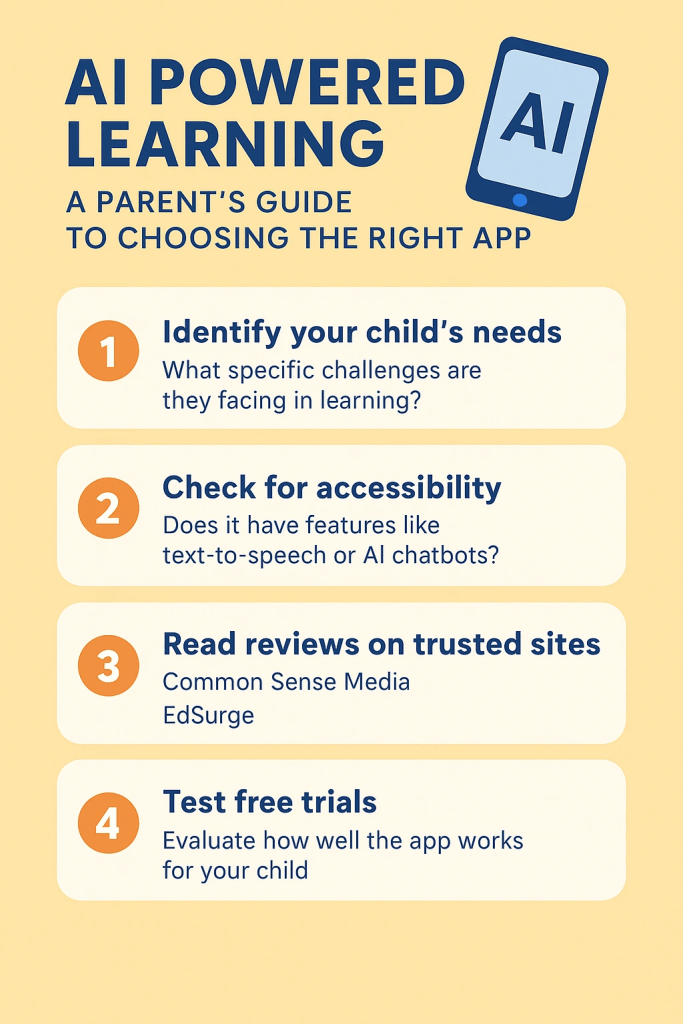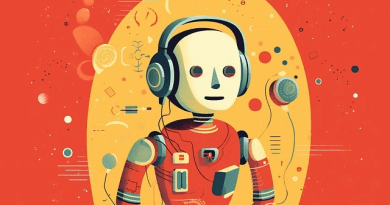AI Powered Learning: A Parent’s Guide to Choosing the Right App ✨
Parents today have a growing range of ai powered apps that promise to support children with learning differences, including dyslexia, ADHD, or visual impairments. While these tools can be incredibly useful, figuring out which one works best for your child can feel overwhelming. This guide explains how to evaluate different apps, highlights what features to look for, and shares some trusted examples.
- Why AI Matters in Learning 🧠
- What to Look for in an AI Powered Learning App 📱
- Types of AI Learning Tools 🎓
- Step-by-Step Guide to Choosing the Right App 🪜
- Step 1: Define Your Child’s Needs
- Step 2: Explore Trusted AI Options
- Step 3: Test with a Free Trial
- Step 4: Check Accessibility Features
- Step 5: Evaluate Progress
- Examples of AI Powered Tools for Kids 🌟
- The Role of Parents 👨👩👧
- Risks and Safety Considerations ⚠️
- Quick Comparison of Leading AI Learning Apps 📊
- Final Thoughts 💡
- FAQs 🤔
Why AI Matters in Learning 🧠
Artificial intelligence is shaping education in powerful ways. According to Brookings, AI in education can help personalize learning, reduce barriers, and improve accessibility.
With ai powered tools, students can receive tailored reading support, real-time feedback, and interactive experiences that match their learning style.
Benefits of AI in Education:
- Personalized learning paths
- Accessible content for students with disabilities
- Real-time support and feedback
- Improved engagement through interactive features
What to Look for in an AI Powered Learning App 📱
When reviewing options, parents should focus on features that match their child’s specific needs. Here are some key aspects:
- Ease of Use: A child-friendly interface is a must
- Accessibility Features: Text-to-speech, voice recognition, or visual aids
- Customization: Ability to adapt lessons based on progress
- Support for Parents: Dashboards or reports that track learning
- Affordability: Transparent pricing or free trials
Types of AI Learning Tools 🎓
Different apps target different needs. Here’s a breakdown:
| Learning Challenge | AI Tool Example | How It Helps |
|---|---|---|
| Dyslexia | Otter.ai | Provides accurate transcription and voice notes to support reading and writing |
| ADHD | Endless Reader | Offers engaging, gamified lessons to keep attention |
| Visual Impairments | Seeing AI | Uses computer vision to describe surroundings and text aloud |
| General Learning | Khan Academy Kids | Adapts difficulty based on progress, powered by AI algorithms |
Step-by-Step Guide to Choosing the Right App 🪜
Step 1: Define Your Child’s Needs
Consider whether your child struggles with reading, focus, or visual processing. Knowing this helps narrow down options.
Step 2: Explore Trusted AI Options
Look at chatbots, ai websites, and tools developed by reputable companies such as OpenAI, Microsoft AI, and Meta AI. Review their credibility and safety measures.
Step 3: Test with a Free Trial
Most apps like ChatGPT online, Claude AI, or Murf AI provide trial versions. Use these to see if the features genuinely help your child.
Step 4: Check Accessibility Features
For example, Google AI chatbot and Dall E AI may support visual aids, while voicebot tools can support speech difficulties.
Step 5: Evaluate Progress
Use built-in reporting features to see if your child’s learning improves over weeks of use.

Examples of AI Powered Tools for Kids 🌟
- Speech & Reading Support: Otter.ai, Murf AI, Narrator’s Voice
- Visual Learning & Creativity: Dall E, MidJourney AI, Imagen AI
- Interactive Learning Apps: Khan Academy Kids, Duolingo ABC
- AI Chat Assistants: ChatGPT OpenAI, Claude AI, Meta AI
The Role of Parents 👨👩👧
AI doesn’t replace parents or teachers. Instead, it works best when used alongside parental guidance. For example:
- Monitor screen time ⏱️
- Discuss results and progress with your child
- Encourage breaks to prevent overstimulation
- Pair apps with offline activities
Risks and Safety Considerations ⚠️
While ai powered apps bring opportunities, they also raise safety concerns. Always:
- Check privacy policies
- Limit personal data input
- Supervise younger children
- Stick to apps from trusted companies like OpenAI, Microsoft AI, and Google Cloud AI
Quick Comparison of Leading AI Learning Apps 📊
| App Name | Strengths | Best For |
|---|---|---|
| ChatGPT OpenAI | Conversational practice, adaptive Q&A | Older children needing tutoring help |
| Murf AI | Text-to-speech with natural voice | Children with reading difficulties |
| Seeing AI (Microsoft) | Visual recognition & narration | Visually impaired learners |
| Duolingo ABC | Fun gamified reading lessons | Young children learning letters & sounds |
Final Thoughts 💡
Choosing the right ai powered app means balancing accessibility, personalization, and safety. Test a few, monitor your child’s progress, and make adjustments as needed. When used wisely, AI can help children learn in a way that feels natural, engaging, and supportive.
FAQs 🤔
What does ai powered learning mean?
It refers to learning supported by artificial intelligence tools that adapt lessons, provide feedback, and improve accessibility for children.
Are ai powered apps safe for kids?
Yes, many are safe if they come from trusted developers like OpenAI, Microsoft, or Google AI. Parents should still monitor use.
Can AI help children with dyslexia?
Absolutely. Tools like Otter.ai and Murf AI can support reading by converting speech to text or reading aloud.
How much do AI learning apps cost?
It varies. Some apps like Khan Academy Kids are free, while others such as Murf AI or ChatGPT Plus may have subscription plans.
Do these apps replace teachers?
No. They’re designed to assist teachers and parents, not replace them. Human support is always important for a child’s learning journey.




